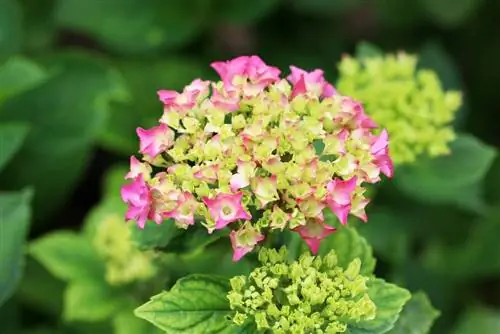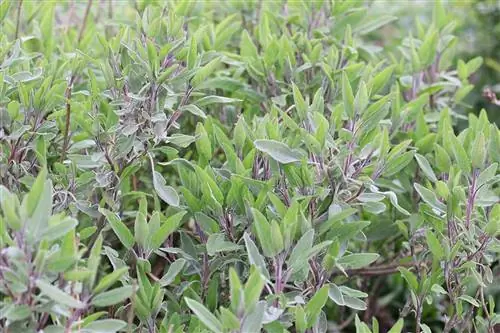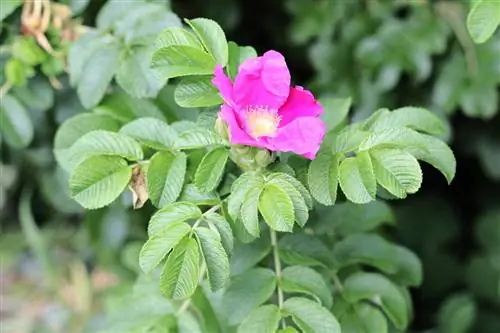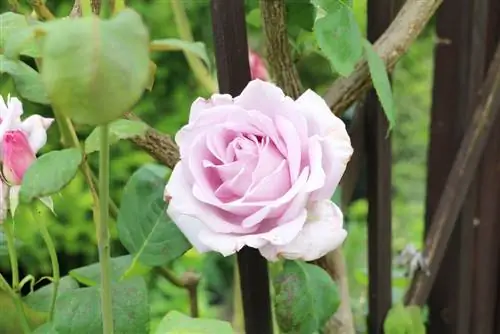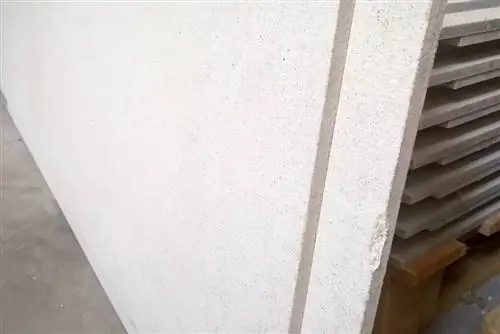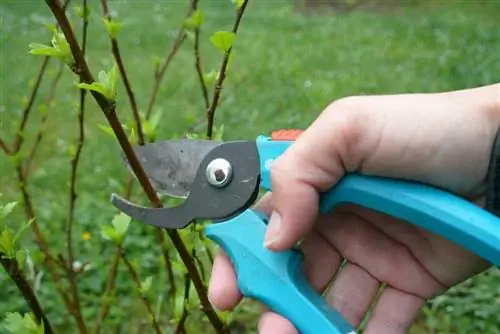- Author admin [email protected].
- Public 2023-12-17 03:39.
- Last modified 2025-01-24 12:45.
The farmer's hydrangea is a type of hydrangea specially bred for the garden. Hydrangeas are common in many regions of Asia and prefer to grow in the undergrowth of forests. The farmer's hydrangea was cultivated in Japan. Seafaring botanists brought them to Europe in the 19th century. Many new varieties and crosses have been created here over the years.
Growth
The farmer's hydrangea, which is often also called garden hydrangea, is a subshrub. That means, botanically speaking, it is partly a woody plant and partly an herbaceous plant. The young shoots are herbaceous, while the older parts of the plant at the base are woody. The new shoots at the beginning of the growth period in spring, the growth heights, arise on the woody parts of the plant. Farm hydrangeas can reach heights of up to 2 meters. They grow densely and upright. Over the years, a sprawling plant shape develops.
Flowers and leaves
With its umbellate inflorescences, which are present from June to October, the farmer's hydrangea is suitable for front garden borders, herbaceous beds and tree disc plantings. As the botanical part of the name macrophylla (large leaf), which the farmer's hydrangea has, suggests, its leaves are large. Their shape is oval and they grow oppositely. The deciduous leaves are shed from the plant in autumn. This sometimes happens even before the flowers have faded. What remains is a sea of dense flower umbels. In autumn the flowers change their color, often from greenish to rusty red. In this way, the farmer's hydrangea shows an impressive play of colors during its long flowering period.
Location
The farmer's hydrangea grows best in shady and semi-shady locations because it was bred from a plant that was native to the undergrowth of forests. Farmer's hydrangeas are also popular near watercourses or groundwater veins. They also prefer places protected from the wind. They love north-western locations. They feel particularly comfortable under trees. These provide shade and protect against hail and heavy rain that could damage the flowers.
Soil texture
A suitable soil for the farmer's hydrangea is a forest-floor-like, humus-rich substrate. Special hydrangea soils, azalea soils or rhododendron soils, which are commercially available, are advantageous. The soil in which the farmer's hydrangea is planted should be rather acidic and low in lime. However, the plant can tolerate a little lime. The acidity of the soil has a major influence on the color of the flowers of the farmer's hydrangea. The higher the pH value of the soil, the redder the flowers will be. With a low pH value, the soil is acidic and more blue tones mix into the flower color.
Planting
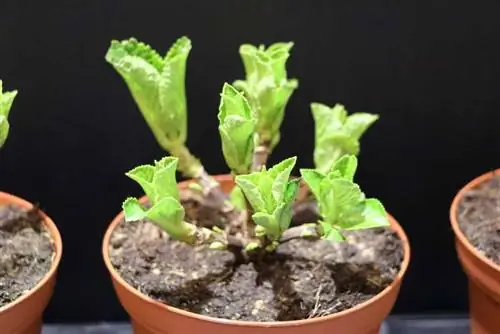
The best time to replant a farmer's hydrangea is spring. Then it has until next winter to take root firmly.
- Remove the plant with roots from the pot
- Remove any rotary root pieces that run along the wall of the pot, as these make growth more difficult.
- don't plant too deep in the garden soil, because the plants are shallow-rooted
- The planting hole does not need to be deeper than the pot in which the plant was purchased.
- Fill the planting hole with special soil or prepared garden soil.
- After pressing the soil, water the plant thoroughly.
Grow in a bucket or pot
Because country hydrangeas grow particularly well in special hydrangea soil and are only hardy in warmer regions, it is sometimes advisable to grow them in a large plant pot or in a bucket.
- Fill the bottom of the planter with pebbles or clay granules
- then put a third of the prepared soil into the container
- Place the farmer's hydrangea in the middle
- Now fill the pot carefully with the rest of the soil so that it is available to all the roots.
- Press down the soil and water the freshly potted farmer's hydrangea.
If the farmer's hydrangea becomes so large that it needs to be repotted into a larger planter, then you should change the pot in spring, at the end of March to the beginning of April, because then the plant tolerates repotting well.
Repotting - here's how to proceed:
- sprinkle pebbles or clay granules on the bottom of the larger pot
- fill the larger pot a third full with prepared soil
- Tilt the farmer's hydrangea and remove the smaller pot
- Remove part of the root mass, or roots that are bent over at the edges, with a sharp knife
- Carefully remove used, leached soil from the roots without damaging the ball
- Place farmer's hydrangea in the middle of the larger pot
- fill in the remaining two thirds of the new soil all around so that all the roots are surrounded by it
- Tamp down the soil and water the plant
Pouring
The garden hydrangea needs a lot of water. The botanical part of its name, Hydrangea, means something like water slurper or water container. In addition, a lot of water evaporates on the surface of the large leaves. It is best to plant the farmer's hydrangea in moist soil that is in the shade and therefore does not dry out. This could be on a wall or a house wall, for example. Potted plants that cannot draw water from the soil should be watered twice a day when it is very warm.
Fertilize
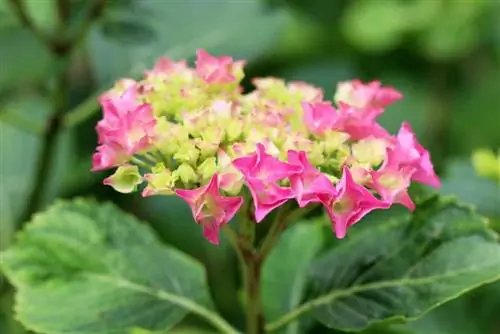
Because the garden hydrangea loves nutrient-rich soil, it should be fertilized. Special hydrangea fertilizer, which is available commercially, is suitable for this. The manufacturer provides information on the packaging about the amount that must be added to the irrigation water and the intervals at which fertilization should be carried out. Fertilization takes place from the beginning of the growing season until the end of August. The fertilizer should be more nitrogen-based and contain less phosphorus, but this depends on the nature of your garden soil.
As a rule, garden soil already contains enough phosphorus but not enough nitrogen, which then has to be added through fertilizer. If you want to grow blue hydrangeas, the fertilizer should contain alum, which will provide the plant with aluminum s alt. The s alt promotes the blue color of the flowers. Fertilization can be stopped in late summer.
Frost protection
Farmer hydrangeas are generally hardy. However, this only applies to regions with relatively mild weather such as Baden-Württemberg. At temperatures below minus five degrees, the plant must be protected from freezing. This is easy with potted plants; they can be brought indoors if the weather forecast is unfavorable. You have to put a little more effort into garden plants to protect them from frostbite. The new shoot tips can also be damaged in late frosts.
A cover with brushwood or leaves sufficiently protects farmer's hydrangeas from severe frost damage.
Fleece hoods are also suitable for covering the plant. The spent inflorescences can remain on the farmer's hydrangea in winter. This protects the new buds from late frosts. If very large potted plants have to remain outdoors, you should protect the root ball from freezing and place an insulating film around the pot.
Varieties
The best known are the hydrangea varieties Endless Summer and Forever & Ever, which are classified as farmer's hydrangeas. Both types of hydrangeas produce new flowers the following year even after vigorous pruning, which is not the case with all hydrangeas. Although the hydrangea varieties are offered in certain flower colors in catalogs, the actual color depends heavily on the soil conditions.
Propagation
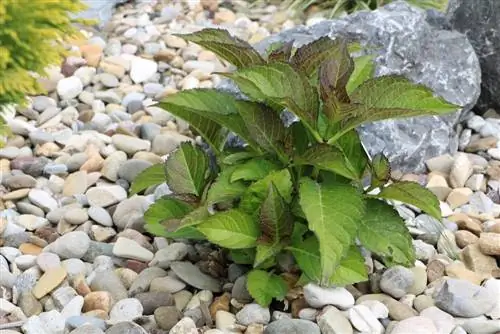
The propagation of farmer's hydrangeas is uncomplicated. The plants can be propagated by cuttings, which is successful in most cases. To do this, cut off a few young shoots with three to four pairs of leaves on which there are no flower buds from the plant in July and remove the lower leaves. Then you should cut the upper remaining leaves in half crosswise to reduce the water evaporation area. The lower shoot sections and the interfaces can be coated with rooting powder or placed untreated in the potting soil. You should then water the cuttings thoroughly. A foil cover helps to keep the soil's moisture constant. The location of the cuttings should be a warm, not too dark place. The first new roots formed after just 14 days.
Pests & Disease Infestation
With sufficient water and in the right location, farmer's hydrangeas are very robust and are rarely attacked by pests. Only occasionally do aphids or weevils attack a farmer's hydrangea. In very warm and humid locations, spider mite infestation cannot be ruled out. Mildew can also sometimes occur. A simple home remedy to combat mildew is milk. The lecithin in milk acts against the fungus and the sodium phosphate contained in the milk strengthens the plant's defenses.
- Mix fresh milk (not UHT milk) with water
- Spray the plant with the mixture
- Repeat the procedure 2 to 3 times a week
If the young leaves of a farmer's hydrangea turn yellow while their leaf veins remain green, this indicates an iron deficiency. The cause can be a soil pH that is too high. A special iron fertilizer or the addition of special soil such as rhododendron soil, azalea soil or hydrangea soil can help here.
Growing Blue Flowers
Blue hydrangea flowers impress with a particularly exotic color in light turquoise. However, in order to make a farmer's hydrangea shine in this special light blue, it requires special treatment. It doesn't help to select the appropriate color in the catalog. All you get is a variety with the ability to bloom blue. When planted in the garden, these varieties usually bloom pink.
To make a farmer's hydrangea bloom blue you need aluminum s alt from the pharmacy or alum containing aluminum s alt from the pharmacy. The s alt, which is also contained in alum, must be added to the plant in the irrigation water from spring onwards. The soil in which the blue-flowering farmer's hydrangea is to be grown must have an acidic pH value between 4.5 and 6. Even if a plant has already bloomed pink, it will turn blue within 2 years after this treatment.
Special hydrangea blue is sometimes available in stores, which makes it easier to grow blue-flowering farmer's hydrangeas. In order not to endanger the breeding result, the administration of phosphate fertilizers should be avoided at all costs, because phosphate prevents the plant from absorbing the aluminum s alt given.
Cutting
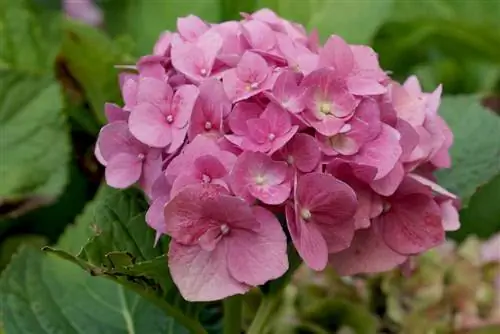
As a rule, the farmer's hydrangea does not need any pruning. It naturally grows in a wonderfully expansive, upward shape. If you do decide to prune, it should only be a slight pruning in order to protect the new shoots. Old inflorescences can be removed above the first pair of intact buds. It is advisable to remove the flowers immediately after they have faded, even if the first flowers fade in the summer.
New shoots will immediately form in these places and a second flowering may occur. That's why, similar to roses that bloom several times, it's worth using scissors every now and then. Plants that have grown too densely can be thinned out by cutting back the oldest shoots to ground level. If you prune the entire farmer's hydrangea heavily, it will usually not start to bloom again until the year after next.
It is advisable to only remove dead or frozen parts of the plant in spring in addition to the old inflorescences. Frozen shoot tips should be cut off up to the height of the first he althy buds.
Pruning of special farmer's hydrangea varieties
How a farmer's hydrangea reacts to being cut back depends on what variety it is. Certain varieties such as Endless Summer are able to sprout again immediately after severe pruning and produce flowers in the same year. That's why you can't go wrong with some varieties if you cut them back heavily in the spring to limit their growth in height and width. In principle, even with varieties that are particularly suitable for cutting, pruning is not really necessary. They tolerate pruning relatively well, but then new flowers begin relatively late in the year. It is therefore advisable to only remove the dead parts of the plant here.

